The pink pigeon (Nesoenas Mayeri) is an endangered pigeon breed that has one of the most amazing stories of all pigeons having been rescued from the very verge of extinction.
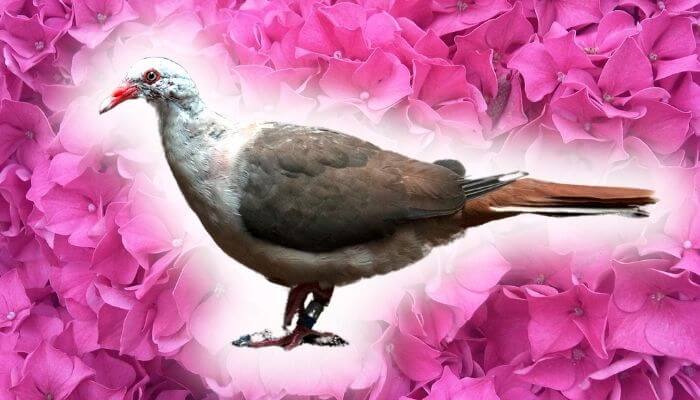
Origins of the Pink Pigeon
The pink pigeon is a bird endemic to the Mascarene islands of Mauritius, it is also known as the Nesoenas Mayeri.
Being endemic means that the species is native to and exists solely on this small island off the east coast of Madagascar in the Indian Ocean, as well as a small number on the predator-free island of Isle aux Aigrettes nearby.
Status of the Pink Pigeon
This pigeon has been classified as vulnerable on the IUCN List since 2018.
This may seem surprising given that the worldwide population is only 500 pink pigeons but back in 1991 there were just 9 or 10 birds (depending on which reports you use).
Due to a sustained conservation and development program, the pink pigeon was saved from extinction, avoiding the same fate of its close relatives, the dodo, another native Mauritian bird, and the Reunion Pigeon which lived on the nearby island of Réunion Island.
Like those two ill-fated birds, the decline of the pink pigeon began with the arrival of Europeans.
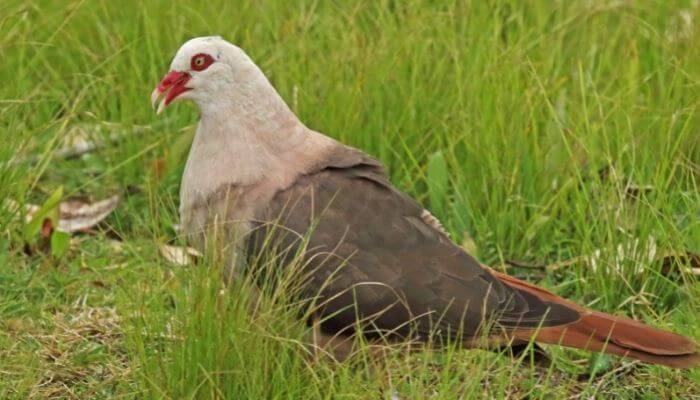
The birds were once widespread throughout the islands, but the pink pigeon is the only remaining native pigeon in the whole Mascarene archipelago.
The native vegetation of the islands was devastated and also subject to invasive non-native plants, predators were introduced, and the birds were hunted for their plump breasts for meat.
Supported by organizations like the National Parks and Conservation Service, and a host of zoos (including the Durrell Wildlife Conservation Trust, Chester Zoo and Paignton Zoo), the Mauritian Wildlife Foundation embarked on an intensive conservation programme.
As a result of the numbers increasing, the IUCN downlisted the pink pigeon from critically endangered to endangered on the Red List in 2000, and then to Vulnerable in 2018.
Even though numbers are increasing, the bird remains vulnerable because the IUCN recognizes that without sustained conservation, the pink pigeon is still subject to disease, loss of habitat and predation.
Pink Pigeon Distribution And Habitat
From information gathered in 2016, there are currently only five different locations where the pink pigeon is found in the wild.
Four of these locations are within the Black River Gorges National Park, and the fifth is on the predator-free Isle aux Aigrettes.
The pink pigeon is by no means a migratory species!
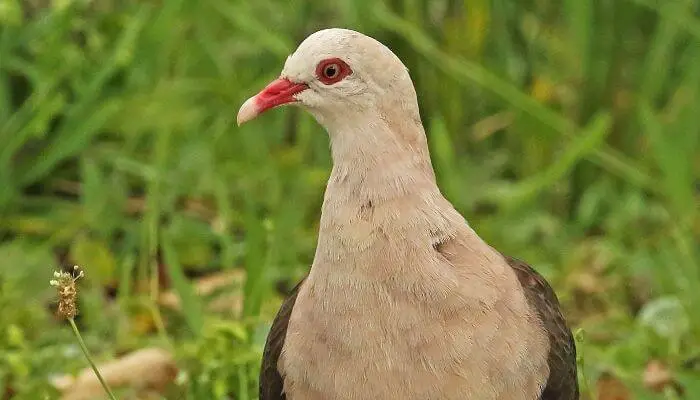
Pink pigeons prefer to set up home in upland evergreen forests, but they have been known to thrive in coastal forests as well.
The main necessity for the bird is to live in a spot with lots of native vegetation that isn’t overrun by invasive species.
Sadly, the destruction of large swatches of such primal forests has been cited as a leading factor in the decline of the pink pigeon and the majority of other breeds that were once native to Mascarene.
The pink pigeon can be seen at a number of the world’s top zoos that actively participate in the conservation program including Bronx Zoo, Chester Zoo, San Diego Zoo, Blank Park Zoo and Bristol Zoo.
The Appearance of the Pink Pigeon
A standard adult pink pigeon will measure roughly 36 – 38 cm (14-16 ins) from beak to tail and weigh around 350 grams (12 oz).
The source of their name, the bird boasts a pale pink-grey plumage on their heads, shoulders and undersides, with a pair of pretty pink feet.
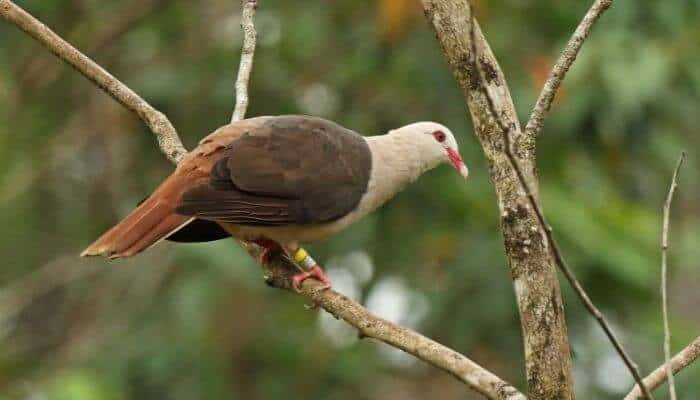
The beak tends to be a darker pink color with a striking white tip, and the wings are dark brown. The tail is broad and rust-colored.
Pink pigeon’s eyes are a dark brown color that is surrounded by an eye-ring of red skin.
Character of the Pink Pigeon
This bird feeds and roosts in small flocks.
The voice of a pink pigeon consists of a flight call that resembles a short, sharp ‘hoo hoo’ noise.
The traditional territorial call of a male pink pigeon takes the form of a series of repeated and extended coos.
Pink Pigeon Diet
In the wild, a pink pigeon eats a mainly herbivorous diet, feeding on the native plants of its home environment as well as certain exotic plants.
They consume lots of different parts of a plant including flowers, buds, seeds, shoots and fruits, and this stems from their behavior of ground feeding, moving around on the forest floors and rifling through leaf litter to find food.
In certain areas where a pink pigeon’s natural food sources are dangerously low, conservationists have had great success in providing them with feeding stations that contain things like whole wheat.
Mating And Breeding Behaviour of the Pink Pigeon
Mating season for a pink pigeon begins in August, although the birds have the potential to breed all year round.
The male begins the mating process with a step and bow display to catch the attention of his chosen female, and once paired up, the breed tends to generally be monogamous.
They build rather flimsy platform nests and embark on protecting a small zone around it, namely from other pigeons because there is little risk from nest predators in their native environment.
A female will typically lay two white eggs and incubate them for two weeks, with the male taking over incubation duties during the day and the female during the night.
An active pair can lay up to ten eggs in a single mating season.
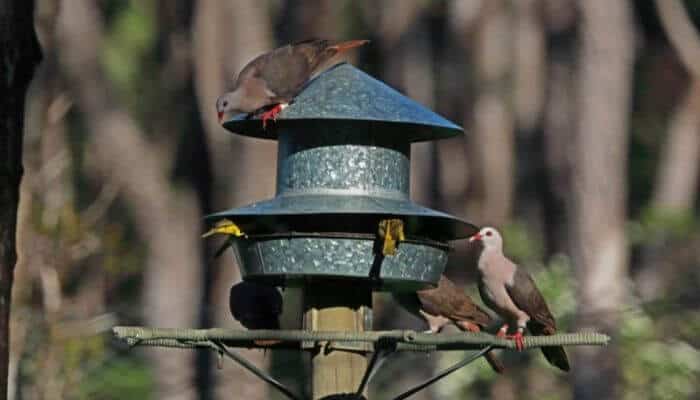
The only time when breeding doesn’t tend to occur during the course of the year for pink pigeons is whilst they are in moult.
Another factor in the bird’s demise is that male pink pigeons have a longer life expectancy (about five more years than the female) so there is a male bias to the population.
The metabolism of egg production takes its toll on the female as she continually produces eggs like a domestic chicken.
Statistics from captive birds show that males are fertile up to the age of 17-18 years whereas females fertility is curtailed at 10-11 years old.
Pink pigeons are not very good parents.
An episode of the UK Channel 4 series, Secret Life of the Zoo, in 2021 documented how the bird handlers at Chester Zoo had to foster out the rare egg from their pair of pink pigeons to be hatched by a pair of barbary doves.
The egg hatched successfully and there is one more pink pigeon in the world.
Care Of Pink Pigeons
Given their vulnerable status and that outside of their natural habitat they are only found in zoos, it’s safe to say that pigeon fanciers are nowhere near being able to boast a pink pigeon among their collection.
Let’s stick to the more common breeds in our lofts and allow the experts to continue doing their thing in order for this beautiful species to continue to grow in number!
